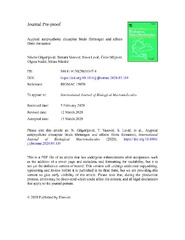Приказ основних података о документу
Atypical antipsychotic clozapine binds fibrinogen and affects fibrin formation
| dc.creator | Gligorijević, Nikola | |
| dc.creator | Vasović, Tamara | |
| dc.creator | Lević, Steva M. | |
| dc.creator | Miljević, Čedo | |
| dc.creator | Nedić, Olgica | |
| dc.creator | Nikolić, Milan | |
| dc.date | 2020 | |
| dc.date.accessioned | 2020-03-31T19:38:26Z | |
| dc.date.available | 2021-03-13 | |
| dc.date.issued | 2020 | |
| dc.identifier.issn | 0141-8130 | |
| dc.identifier.uri | https://cherry.chem.bg.ac.rs/handle/123456789/3896 | |
| dc.description.abstract | Clozapine is an atypical antipsychotic used for the treatment of schizophrenia. The prescribed target daily doses may reach 900 mg. Literature studies report a connection between clozapine usage and thrombosis development. Our in vitro study aimed to provide insight into molecular bases of this observation, investigating clozapine binding to fibrinogen, the main plasma protein involved in hemostasis. Fibrinogen/clozapine interaction was confirmed by protein fluorescence quenching, with an affinity constant of 1.7 × 105 M−1. Direct interactions did not affect the structure of fibrinogen, nor fibrinogen melting temperature. Clozapine binding affected fibrin formation by reducing coagulation speed and thickness of fibrin fibers suggesting that in the presence of clozapine, fibrinogen may acquire thrombogenic characteristics. Although no difference in fibrin gel porosity was detected, other factors present in the blood may act synergistically with altered fibrin formation to modify fibrin clot, thus increasing the risk for development of thrombosis in patients on clozapine treatment. ORAC and HORAC assays showed that clozapine reduced free radical-induced oxidation of fibrinogen. All observed effects of clozapine on fibrinogen are dose-dependent, with the effect on fibrin formation being more pronounced. | |
| dc.publisher | Elsevier | |
| dc.relation | info:eu-repo/grantAgreement/MESTD/Basic Research (BR or ON)/173042/RS// | |
| dc.relation | info:eu-repo/grantAgreement/MESTD/Basic Research (BR or ON)/172035/RS// | |
| dc.rights | embargoedAccess | |
| dc.rights.uri | https://creativecommons.org/licenses/by-nc-nd/4.0/ | |
| dc.source | International Journal of Biological Macromolecules | |
| dc.subject | Binding | |
| dc.subject | Coagulation | |
| dc.subject | Clozapine | |
| dc.subject | Fibrinogen | |
| dc.subject | Hemostasis | |
| dc.subject | Thrombosis | |
| dc.title | Atypical antipsychotic clozapine binds fibrinogen and affects fibrin formation | |
| dc.type | article | |
| dc.rights.license | BY-NC-ND | |
| dcterms.abstract | Левић, Стева М.; Миљевић, Чедо; Николић, Милан; Недић, Олгица; Васовић, Тамара; Глигоријевић, Никола; | |
| dc.citation.volume | 154 | |
| dc.citation.spage | 142 | |
| dc.citation.epage | 149 | |
| dc.identifier.wos | 000533508600016 | |
| dc.identifier.doi | 10.1016/j.ijbiomac.2020.03.119 | |
| dc.citation.rank | aM21~ | |
| dc.description.other | This is the peer-reviewed version of the article: Gligorijević, N.; Vasović, T.; Lević, S. M.; Miljević, Č.; Nedić, O.; Nikolić, M. Atypical Antipsychotic Clozapine Binds Fibrinogen and Affects Fibrin Formation. International Journal of Biological Macromolecules 2020, 154, 142–149. [https://doi.org/10.1016/j.ijbiomac.2020.03.119] | |
| dc.type.version | acceptedVersion | |
| dc.identifier.scopus | 2-s2.0-85081672799 | |
| dc.identifier.fulltext | https://cherry.chem.bg.ac.rs/bitstream/id/16860/Atypical_Antipsychotic_Clozapine_acc_2020.pdf |


